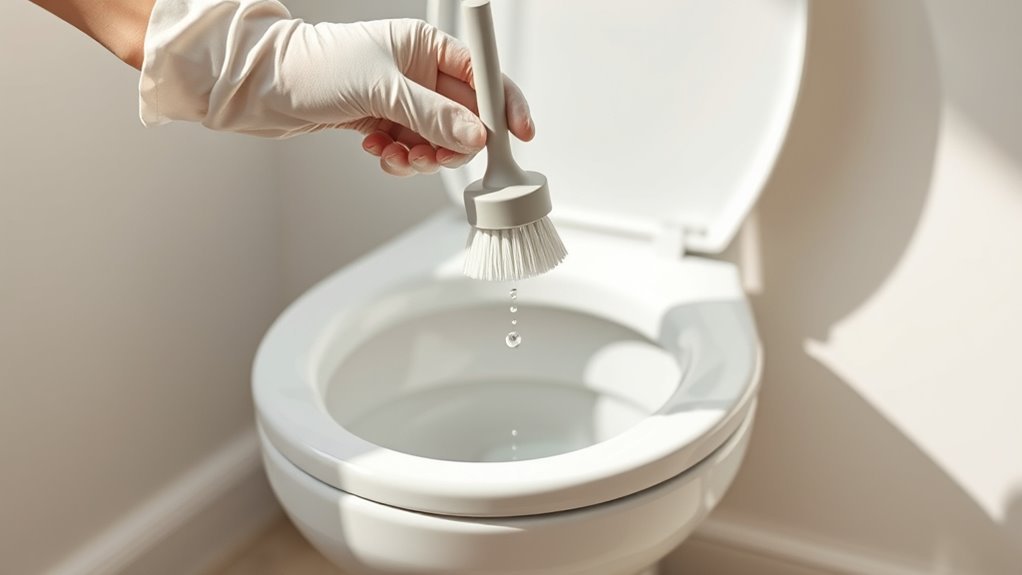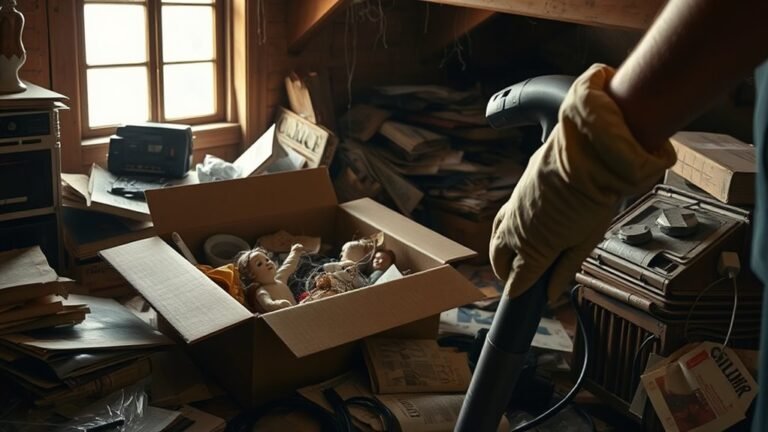Washing Toilet Without Damage
To wash your toilet without causing damage, choose eco-friendly, pH-balanced cleaners made for porcelain and avoid abrasive or acidic products. Use soft-bristled brushes with nylon or silicone bristles to scrub gently. When removing hard water stains, try a vinegar and water solution instead of harsh chemicals. Always flush and wipe the seat and rim carefully. Following these tips helps protect your toilet’s finish and functionality. For more tips on keeping your toilet spotless and safe, keep exploring careful cleaning methods.
Choosing the Right Cleaning Products
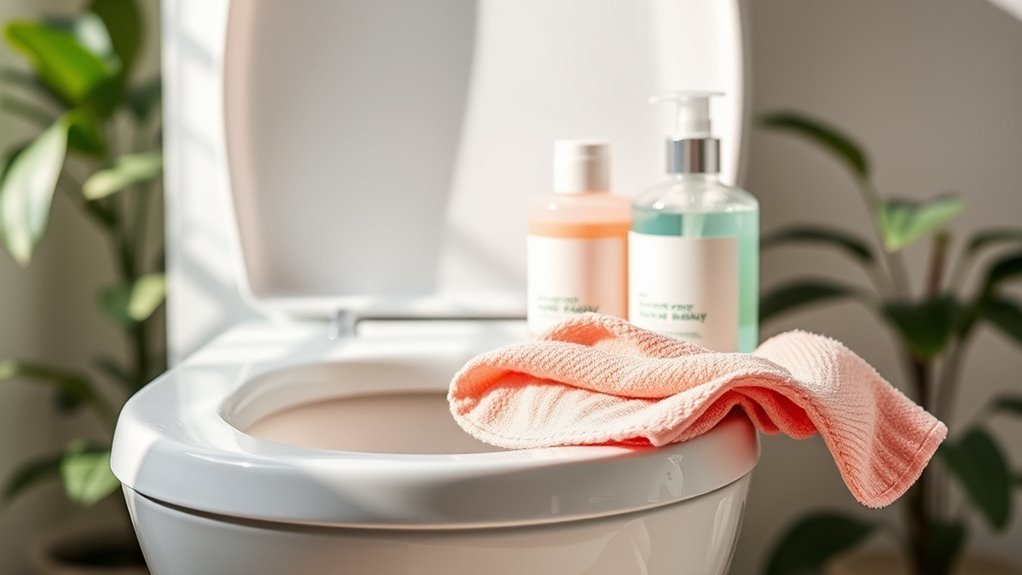
Before you start scrubbing, you’ll want to pick cleaning products that won’t damage your toilet’s surface. Choosing eco friendly options lets you clean effectively without harsh chemicals that can erode porcelain or harm your health. Look for pH balanced cleaners designed specifically for toilets—they’re gentle yet powerful enough to tackle stains without causing wear. This approach gives you the freedom to maintain a spotless bathroom confidently, knowing you’re not compromising your toilet’s finish or the environment. Avoid abrasive or acidic cleaners that can dull or scratch surfaces over time. By selecting the right products, you protect your toilet’s longevity and your well-being, making your cleaning routine both safe and satisfying.
Tools That Won’t Scratch Porcelain
You’ll want to use soft-bristled brushes and non-abrasive cleaning pads to protect your toilet’s porcelain surface. These tools clean effectively without causing scratches or damage. Choosing the right tools makes a big difference in maintaining your toilet’s shine.
Soft-Bristled Brushes
Choosing the right brush is key when cleaning your toilet without scratching the porcelain. Soft-bristled brushes offer the perfect balance of effective cleaning and gentle care. When exploring toilet brush types, focus on bristle softness to protect your toilet’s surface. Here’s what to evaluate:
- Opt for brushes with nylon or silicone bristles—they’re soft yet durable.
- Avoid stiff, wire bristles that can cause scratches and damage.
- Look for brushes designed specifically for porcelain toilets.
- Choose a brush with a comfortable handle to give you freedom of movement.
Non-Abrasive Cleaning Pads
Several types of non-abrasive cleaning pads can help you scrub your toilet effectively without scratching the porcelain surface. When choosing cleaning pad types, focus on those made from non abrasive materials like foam, microfiber, or cellulose. These options let you clean thoroughly while preserving your toilet’s finish and your freedom to maintain it yourself.
| Cleaning Pad Type | Material | Best Use |
|---|---|---|
| Foam Pad | Soft foam | Light stains |
| Microfiber Pad | Microfiber fibers | Tougher grime |
| Cellulose Sponge | Natural cellulose | General daily cleaning |
| Nylon Mesh Pad | Soft nylon | Stubborn spots |
| Silicone Pad | Flexible silicone | Delicate surfaces |
Pick the right pad, and you’ll keep your toilet spotless without damage.
Step-by-Step Gentle Cleaning Process
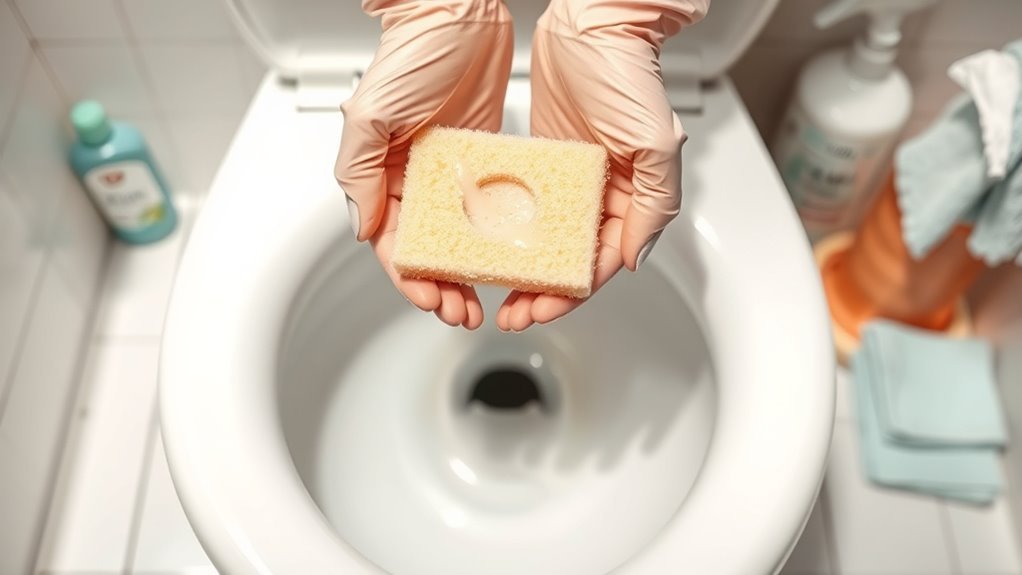
Before diving into the cleaning, gather all your gentle supplies so you won’t have to stop midway. Choose gentle solutions and eco friendly options to protect both your toilet and the planet. Here’s a simple, effective process:
Gather gentle, eco-friendly supplies before cleaning to protect your toilet and the environment effortlessly.
- Put on gloves to keep your hands safe.
- Apply your chosen gentle cleaner evenly inside the bowl.
- Use a non-abrasive cleaning pad to scrub softly, focusing on stains and buildup.
- Flush the toilet to rinse away residue, then wipe the seat and rim with a damp cloth.
Removing Hard Water Stains Safely
You’ll want to tackle hard water stains with products that effectively break them down without harming your toilet’s surface. Using gentle, protective cleaning methods helps remove buildup while preventing scratches or damage. Let’s explore safe techniques that keep your toilet both clean and intact.
Effective Stain Removal
Hard water stains can be stubborn, but you don’t have to resort to harsh chemicals that might damage your toilet’s surface. You can keep it spotless while embracing eco friendly solutions. Here’s how to tackle those stains effectively:
- Mix equal parts white vinegar and water in a spray bottle for a gentle yet powerful cleaner.
- Apply the solution generously to stained areas and let it sit for 10-15 minutes.
- Scrub with a soft-bristle brush or sponge to avoid scratching.
- Rinse thoroughly with warm water and repeat if necessary.
Protective Cleaning Methods
Although removing tough water stains can be challenging, using protective cleaning methods guarantees you won’t damage your toilet’s surface. You’ll want to choose eco friendly options that clean effectively without harsh chemicals. Vinegar and baking soda are excellent choices, offering gentle techniques to break down mineral buildup safely. Apply vinegar directly to stains and let it sit before scrubbing lightly with a soft brush. Avoid abrasive tools or strong acids that can scratch or erode your toilet’s finish. These gentle methods not only protect your porcelain but also free you from worrying about toxic residues. By sticking to eco friendly options and gentle techniques, you maintain both the environment’s health and the integrity of your toilet, giving you the freedom to clean confidently and safely.
Preventing Damage From Harsh Chemicals
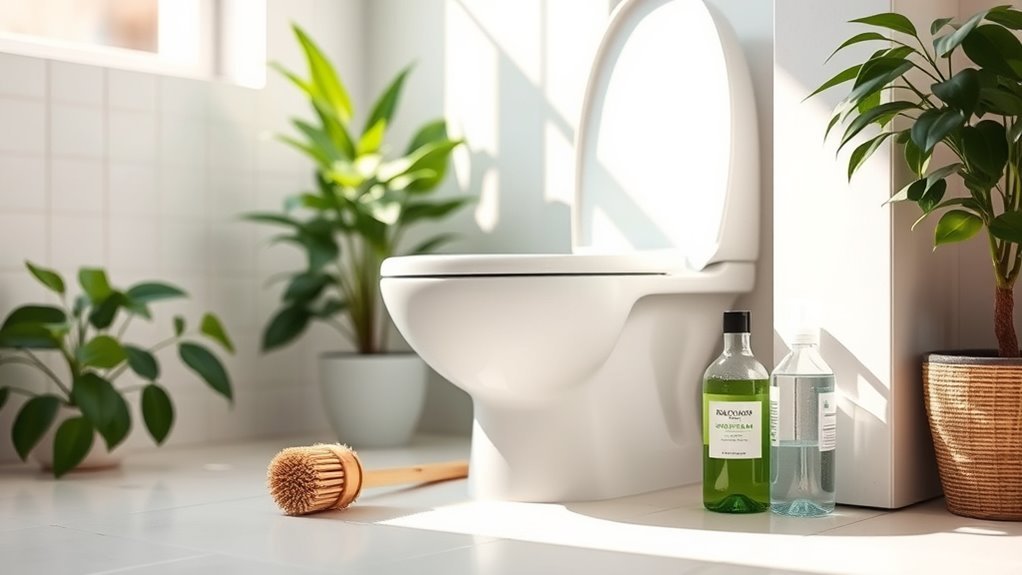
Since harsh chemicals can erode your toilet’s surface and damage its components, it’s important to choose cleaning products carefully. You want to maintain freedom from worry and wear, so consider these steps:
- Opt for eco friendly alternatives that clean effectively without toxic ingredients.
- Use chemical free solutions like baking soda and vinegar to tackle stains gently.
- Avoid bleach and ammonia, which can corrode seals and discolor porcelain.
- Test any new product on a small, hidden area first to verify it won’t cause damage.
Regular Maintenance Tips for Longevity
To keep your toilet in good shape over time, regular maintenance is key. You’ll want to adopt simple preventive measures that protect your toilet’s finish and functionality. Start by scheduling routine inspections to catch small issues like leaks or mineral buildup early. Use gentle cleaners, avoiding harsh chemicals that can erode surfaces or damage seals. Make it a habit to wipe down the exterior and flush handle regularly to prevent grime accumulation. Checking the tank components every few months guarantees everything operates smoothly without wasting water. By staying proactive with these steps, you free yourself from costly repairs and keep your toilet running reliably. Embracing these maintenance habits lets you enjoy your bathroom with confidence and freedom, knowing your toilet’s longevity is secure.
Frequently Asked Questions
Can I Use Vinegar to Clean My Toilet Safely?
You might wonder if vinegar is the secret weapon you need for toilet cleaning—here’s the truth. Vinegar benefits include natural disinfectant properties and tackling stains without harsh chemicals. It’s gentle yet effective, giving you freedom from toxic cleaners. Just pour some vinegar, let it sit, then scrub lightly. You’ll get a sparkling toilet without worrying about damage. So yes, you can safely use vinegar and enjoy a cleaner, fresher bathroom naturally.
How Often Should I Deep Clean My Toilet?
You should aim for a toilet cleaning frequency of deep cleaning about once a week. This helps you enjoy deep cleaning benefits like eliminating stubborn stains, bacteria, and odors, keeping your bathroom fresh and hygienic. Sticking to this routine means less hassle later, giving you more freedom to focus on things you love instead of scrubbing endlessly. Regular deep cleaning keeps your toilet in top shape without much effort.
Is Bleach Harmful to Toilet Seals?
Yes, bleach can be harmful to toilet seals because it’s a strong chemical that may cause rubber and plastic parts to degrade over time. If you want to protect your toilet’s longevity and enjoy some freedom from frequent repairs, consider using bleach alternatives like vinegar or baking soda. These options are gentler and effective for toilet maintenance, helping you keep things clean without risking damage to your seals or plumbing components.
What’S the Best Way to Clean Under the Toilet Rim?
Imagine the toilet rim as a shadowy cave where grime hides. To free it, you’ll want to grab specialized rim cleaning tools or a thin, flexible toilet brush. Use gentle, circular toilet brush techniques to sweep away buildup without scrubbing harshly. This lets you reclaim cleanliness without feeling trapped by stubborn stains. With the right tools and a light touch, you’ll liberate every hidden corner, making your toilet sparkle effortlessly.
Can Natural Cleaning Agents Damage Toilet Porcelain?
You might wonder if natural cleaners can harm your toilet’s porcelain. Generally, they’re safe because they use gentle ingredients, helping you keep porcelain safety intact. Unlike harsh chemicals, natural cleaners won’t erode or scratch the surface, giving you freedom to clean without worry. Just avoid abrasive tools and test any new cleaner on a small spot first. That way, you’re protecting your toilet while embracing eco-friendly cleaning.
